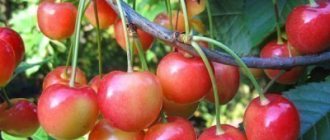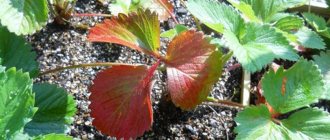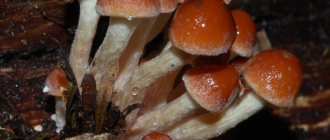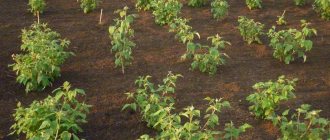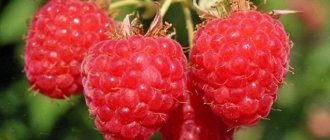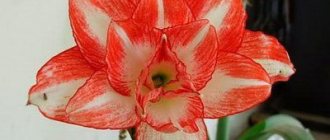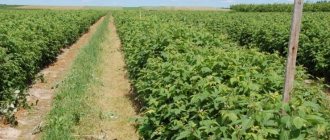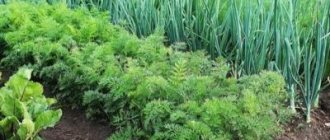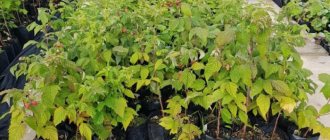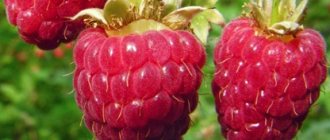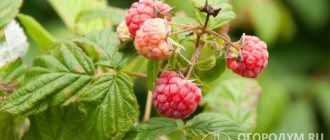Planting raspberry seedlings in spring is only a complex process at first glance. Following a few recommendations and the desire to pay a lot of attention to the cuttings in the first couples will be crowned with success. A correctly selected and prepared site, high-quality planting material and proven advice from experienced gardeners are the basis for success.
How to plant raspberry seedlings in spring?
Raspberries are known not only for the beneficial qualities and sweet taste of their berries, but also for their demanding nature. To grow fruit-bearing raspberries, you will have to put in a lot of effort when planting purchased seedlings on the site.
- Raspberry seedlings, once identified in their permanent place, will grow there for many years, therefore it is important to correctly select the soil on the site. The best option is a sunny place, but well protected from wind and drafts. The shadow will not affect the green mass of the bush, but the harvest may not be expected. The shoots begin to reach towards the sun and as a result, buds form on the unripe tops. In winter they will freeze.
- It's a good idea to think about the neighborhood. An apple or plum tree is considered the best choice, but raspberries will begin to oppress currant bushes.
- The seedling needs to create the right conditions for rapid growth, because sap flow begins in the spring. Overmoistening of the soil is detrimental to the root system. Core loamy, well-drained and nutritious soil is the ideal combination.
How to choose raspberry seedlings for planting in spring?
In the spring, the season of gardening fairs and festivals starts in almost every city. There you can find seedlings for every taste. However, practice has shown that purchasing planting material without knowing the seller is dangerous. The purpose of a fair or spontaneous market is to sell goods, therefore there are few real expert gardeners there, most often resellers. Even if the seedling is viable, it may turn out to be wild or a completely different variety. There are several criteria for choosing a raspberry seedling when purchasing.
- Please pay attention to the packaging. If the bushes are sitting in plastic bags, there is a high probability of root rot. The survival rate of the root system decreases significantly.
- The smaller the seedling, the better it adapts to its new location.
- The seedling should have two to four shoots. In nurseries or online stores they leave three. A short small stem will take root better, a long shoot will die.
How to store raspberry seedlings before planting?
After purchasing in early spring, you will have to choose a cool place so that the planting material survives until the required time. It is recommended to plant in small deep pots or plastic bottles. The room must have a constant low positive temperature. This could be a balcony, a northern room in a country house, or even a steam room in an inactive bathhouse. When it comes to storing raspberry seedlings, it is important to provide moderate, dim lighting; complete darkness is not suitable.
When to plant raspberry seedlings in spring?
It is difficult to talk about specific dates or even approximate periods, because for each climatic region the change in weather conditions is individual.
- Southern regions with early spring and hot summers are planted exclusively in autumn. In the spring, the seedling will enter the bud stage without having time to take root well, as a result it dies.
- The middle zone allows gardeners to work in spring and autumn without fear of crop loss. If snowfall occurs late in your area, establishment is more likely to occur in the spring. Planting of raspberry seedlings occurs from mid-April to May. It is important to monitor the forecasts here: if a hot, dry May immediately follows after a cold April, it is better to postpone planting until autumn.
How to treat raspberry seedlings before planting?
Properly selected planting material and its storage do not guarantee successful rooting. Soaking can correct all the gardener’s mistakes at these two stages and protect against possible difficulties.
- The drug "Aktara" or any other soil insecticide will protect the root system. In the spring, the larvae of the cockchafer and wireworm actively make themselves known, eating the roots. Soaking will replenish moisture loss if storage was incorrect.
- If everything was done correctly before planting raspberry seedlings in the spring, you can dip the roots in mash before planting. To prepare it, 6 g of Aktara are diluted in three liters of water and a kilogram of Kornevin and clay with chernozem are added to the solution.
How to properly plant raspberry seedlings in spring?
After selecting the site and preparing it, you can begin to work. There are two methods for arranging seedlings.
- The bush method is suitable for planting individual bushes, each with up to ten stems. The distance between raspberry seedlings when planting is one meter, and the same will be between the rows.
- Young stems are planted using the ribbon method. This is a continuous strip of young animals. There will be already two meters of distance between the rows, and no more than 60 cm between the pits. Before planting, supports in the form of trellises are installed with ribbons.
Mulching raspberry seedlings with sawdust
When introducing organic matter under bushes, the emphasis is on nitrogen. In spring it is often washed away, and seedlings need a lot of water. Mulching solves these two problems. Mulching should begin after fertilizing, when replacement shoots reach 30 cm. This is true for the cool zone. You can also mulch in early June, when the soil is well warmed up.
Mulching raspberries in spring has its own characteristics, depending on the type of covering material. Sawdust, when decomposing cellulose, removes nitrogen from the soil, therefore, when fertilizing, it should be applied a little more than the recommended norms. However, an excess of nitrogen leads to fattening of the bushes: there is a lot of greenery, but few berries.
Caring for raspberry seedlings in spring
Planting raspberry seedlings in spring has several aspects. When planting, it is important to water each cutting generously. After digging, the soil is not compacted, but shrinks on its own after water is added. 7 liters of water are poured under each seedling. In the spring, raspberry seedlings need constant care.
- Before planting or after it, shoots should be cut to a height of 30 cm. This is done to enhance the flow of the plant’s strength to the root system. The stems will pull everything, therefore getting rid of them will lead to the active growth of root shoots, and the survival rate will also increase.
- After abundant watering, the ground under the cuttings is mulched.
- When the cuttings take root, they can be actively fed with complex fertilizers. Weeds should not be left; wheatgrass is especially dangerous for young growth.
- Water thoroughly once a week. This will promote good root growth. Frequent small waterings are not suitable for raspberries.
- The bushes must be tied up to ensure sun access to all branches.
When do raspberries begin to bear fruit after planting seedlings?
Remontant varieties will delight you with the first berries already this season. If the bushes were planted in autumn or early spring, then the first harvest has time to ripen already in August at the end of the month. For ordinary raspberries, fruiting occurs only a year after planting. The question of when raspberries produce their first harvest has its own nuances. New gardeners wait to pick berries every year, but only get a small handful.
Raspberry propagation methods and their features
There are many ways to grow raspberries. Preference is given to vegetative methods.
Root cuttings
Root cutting is a part of the root on which there are lateral branches capable of independent growth after separation from the rhizome.
Signs of a suitable root cutting:
- thickness – more than 2 mm, optimal – 5 mm;
- length – 10-15 cm;
- number of buds – 1-2 pieces.
Dig up the soil, moving 40 cm away from the bush. Carefully separate the lateral shoots from the central rhizome and remove them from the soil, being careful not to damage the small roots.
Further actions depend on the time of year. Let's consider the process using the example of propagation by root layering in the spring.
Breeding order in spring:
- Place the prepared shoots in furrows prepared in advance for planting. Their depth is 10-15 cm.
- Cover with soil and water generously.
- Cover the plantings with film to create a greenhouse effect and speed up the appearance of green shoots - as soon as they appear, remove the cover.
If it is cold outside, the offspring can be planted not in furrows, but in boxes. And then put them in a greenhouse. The minimum container depth is 20 cm. The boxes are filled with a mixture of peat and sand (1:1). Plants are planted when warm weather sets in - around the end of May.
During autumn propagation, the dug out shoots are sent for storage. Features of autumn breeding:
- The root shoots are placed in a trench (depth - 15 cm) and covered with soil. The top of the furrow is covered with sawdust or leaves. The second option is to put it in boxes filled with sand and store it in a cellar.
- Storage temperature for planting material is 0…+4°С. If it drops below this value, the shoots will die; if it is higher, they will sprout earlier than necessary.
The survival rate of root cuttings reaches 80%. Gardeners believe that this method of propagation is best used in the fall. The optimal age of mother bushes is 3-4 years.
Young bushes begin to bear fruit 2-3 years after planting.
Recommendations for propagating raspberries by root cuttings can be found in the following video:
Green cuttings
This breeding option is only suitable for summer. Cutting is carried out in cloudy weather.
The order of propagation by green cuttings:
- Cut off the green shoot at ground level. Cut into pieces of 8-10 cm.
- Place the cuttings for 12 hours in a solution of a growth stimulator, for example, Kornevin. The liquid should not be colder than +18°C, otherwise the cuttings will not take root.
- Plant the cuttings in the trenches.
Plant the cuttings in a greenhouse, as propagation takes place towards the end of summer, on the eve of cold weather. If planting is done in open ground, the plantings are covered with film.
After a couple of weeks, feed the plants. Dilute a liter of mullein in 10 liters of water and water them. After 1.5-2 months, transplant the seedlings to a permanent place.
On a young raspberry bush, the harvest will appear in the second year.
An experienced gardener will tell you about propagation by green cuttings in the following video:
Lignified cuttings
This propagation option is used in the fall, after the leaves fall and the stems turn brown. Lignified shoots form on roots from adventitious buds. For propagation, shoots located at a distance of 0.3 m from the bush are used.
Breeding order:
- In the first half of September, trim off the woody cuttings with pruning shears.
- Divide each shoot into pieces 25-30 cm long.
- Place the planting material in the cellar, having previously wrapped it in cloth and immersed it in wet sand.
- When February comes, renew the lower cuts and soak in water for 12 hours.
- Place the cuttings in honey water (dilute 1 tsp in 1 liter). In a month, roots will appear.
- When the roots are 1 cm long, move the cuttings into containers with soil. Make wide holes, place seedlings there and cover the roots with sand.
- Water the soil regularly, but not excessively. If overwatered, the roots will rot.
- After three weeks, the seedlings will take root and leaves will grow on them.
- Plant in the ground in May.
Bushes obtained by planting lignified cuttings produce the first berries in the second year.
Green root shoots
This method is used in the spring. It allows you to quickly and easily obtain a mass of planting material. The harvest from bushes obtained from green root suckers is harvested the next year after planting.
Breeding order:
- Inspect the tops. The mother bushes should not be damaged by diseases or pests. If a plant is attacked by a raspberry fly, it is prohibited to use it for propagation.
- Step back 40-45 cm from the bush and dig up shoots that have reached 15-25 cm in height. Remove the plants along with the roots and a clod of soil.
- Prepare a hole for planting according to the size of the roots - they should fit freely in it. Sprinkle the roots with a mixture of compost and humus. Add 1 more tbsp to it. l. wood ash.
- Water the seedlings and mulch the soil.
When raspberries are propagated by green root suckers, the survival rate reaches almost 100%.
Apical layering
The method is effective for purple and black raspberries. It is used in late August-early September. When the tops look like loops, it means they are suitable for rooting.
The order of propagation by apical layering:
- Start the propagation process in May - select flexible and thin shoots, and pinch the tops of them so that the lateral roots develop better.
- Prepare the soil for the formation of layering. Loosen it, add peat and sand - a bucket per 1 sq.m.
- Dig furrows. The recommended depth is 10 cm. Tilt the stem so that 10-15 cm of its upper part is in contact with the ground.
- Secure the top with a wire staple to the bottom of the furrow.
- Cover the stacked tops with soil and water.
- At the beginning of autumn, using pruning shears, separate the stems of the mother bush from the young ones, retreating 30 cm.
- When the leaves fall, trim off the remaining portions of the mother shoots.
- Trim the tops of the cuttings - this will improve the growth of side shoots.
- Dig up cuttings with a clump of soil and replant.
Fruiting of bushes planted by rooting the tops begins two years after planting.
About the features of raspberry propagation by apical branches, see the following video:
Dividing the bush
As soon as the snow melts, the raspberries begin to grow. Already in March it can be planted by dividing it into parts. But the best time for this method of reproduction is considered to be autumn.
Reproduction order by division:
- Dig up a bush with roots. Try not to damage them. Gently shake the soil from the roots.
- Using sharp pruning shears, divide the bush so that each part has 2-3 stems.
- Prepare planting holes. The optimal depth is 30-40 cm. Mix peat with sand (3:1).
- Place the seedlings in the holes, cover with the prepared soil mixture, and water.
This method is good for its simplicity and efficiency - the harvest is harvested from new bushes the very next year.
Growing raspberries from seeds
This is the longest and most difficult method. Ordinary gardeners practically do not use it. Firstly, there are a great variety of vegetative methods for breeding raspberries, and secondly, the seed method does not guarantee the preservation of varietal characteristics.
Propagation by seeds is usually practiced by breeders. They use it to develop new varieties. It is difficult for amateur gardeners to grow a varietal plant from seeds, but they produce shrubs for forming hedges.
Seed propagation order:
- Pick the largest berries from raspberry bushes. Take only fully ripe fruits.
- Crush the berries in a saucepan.
- Rinse the resulting mass in water to separate the seeds from the pulp. Use a sieve to strain out the water.
- Soak the seeds in water for 24 hours.
- Remove the seeds from the water and mix it with moistened sand. Place in fabric bags and store in the refrigerator.
- When March comes, sow the seeds in a container with soil mixture to a depth of 5 mm. Sprinkle the seeds with sand and cover the crops with a glass lid, water and ventilate them regularly.
- After the leaves appear, begin hardening off the seedlings. Unhardened seedlings will die. Take the boxes with seedlings out into the fresh air, gradually increasing the walking time from 1 to 24 hours.
- Plant the seedlings in mid-May. Plant in the morning. Dig holes 10-15 cm deep and place the seedlings there, sprinkle with soil and water.
- Cover the plantings with film. After a month, remove it. In a couple of weeks, new leaves will appear on the seedlings.
The first berries from bushes obtained by seeds are collected 2-3 years after sowing.
Raspberry seeds can be stored in the basement. To do this, they are placed in boxes with moistened moss - it is sprinkled with water 2 times a month.
Scottish method of propagating raspberries
This method is considered very effective, as it allows you to quickly and easily obtain a lot of high-quality planting material.
Procedure:
- In March, add fertilizer to the soil for the bushes. Mix peat, sand and sawdust (1:1:1). For 1 sq.m - a bucket of soil mixture. This event is aimed at activating the formation of buds on the rhizomes.
- In September, the roots are divided into sections, collected in small bunches, wrapped in cloth, placed in a box with damp sand and taken to the basement.
- With the onset of spring, move the root sections into a mixture of sand and peat (1:1). Water thoroughly. In a couple of weeks, many green shoots will appear.
- Plant the sprouts along with rhizomes in boxes. They quickly take root there.
- After a week, transplant the seedlings into separate pots. Fill them first with a soil mixture of turf, sand and peat. Supplement the mixture with superphosphate and dolomite flour - add 5 and 50 g, respectively, per 100 liters of soil mixture.
A month after planting in pots, raspberry seedlings can be transplanted to a permanent place. Only 2 years will pass, and the young bushes will give their first harvest.
Raspberry nutrition
Even young bushes do not always bear fruit well. When solving the problem of how to increase raspberry yields, gardeners, first of all, try to feed the plantation. Adding manure, compost or peat at the rate of 15 kg per 1 square meter will help increase fruiting. m. But here you should also take into account the composition of the soil:
- more organic matter should go into clayey soil to improve the quality of the soil;
- in sandstones, all fertilizers quickly rot, so fertilizing will have to be done annually; in this case, fewer organic components are taken than mineral ones.
Nitrogen fertilizers (urea, saltpeter), which are applied to the site in stages, help to significantly increase the yield:
- in early April;
- in the middle of May;
- in the second ten days of June.
In one go, 2.5 kg of fertilizers are used for every hundred square meters of berry garden. In addition to nitrogen nutrition, potassium nutrition is also necessary, which is applied to the soil once a year, regardless of the season (autumn or spring). Potassium-containing mineral water requires 3-4 kg per hundred square meters. As an alternative, you can use wood ash in an amount of 40 kg.
There are two types of natural nutrition: passive and active.
Passive is when there are some reserves already in the soil.
For example, you got black soil, you planted it and everything grows on its own. If you plant mushroom spores in a raspberry field, then this is a great thing. Mushrooms grow in symbiosis with raspberry roots - this is very good. If you also create a good microclimate and mulch the soil, you will have an excellent result. Mushrooms are good. Active nutrition is due to the active activity of fungi, microorganisms and worms in the soil. A prerequisite is mulch.
Productivity
Raspberries will bear fruit in any case, even if their location is a forest. But how high the yields are, first of all, depends on the variety. The table below will show how many raspberries can be harvested from 1 acre under average agricultural conditions.
Yield indicators of some varieties
| Variety | Average fruit weight, g. | Productivity, kg/are |
| Hussar | 5 | 85 |
| Gloria | 4.5 | 90 |
| Yellow giant | 6 | 100 |
| Mollis promise | 4 | 120 |
| Glen Ample | 4 | 150 |
| Hercules | 10 | 180 |
| Arbat | 12 | 200 |
| Maroseyka | 10 | 200 |
| Cumberland | 2 | 240 |
Important. The type of culture plays a big role. Remontant varieties are more productive because they allow fruit to be harvested twice a year. But if you transfer such raspberries into the category of one-time fruiting, you can get higher yields.
When selecting suitable varieties, their ability to adapt to climatic conditions is taken into account. For example, raspberries, for which Kuban is a fertile land in all respects, will also not bear fruit abundantly if it gets to the Leningrad district.
It is not without reason that a beginner in gardening is interested in the question of how to increase the yield of raspberries, because agricultural technology contains many secrets that are learned with experience.
If, while searching for advice on the Internet, the phrase “Miro raspberry” appears, you should keep in mind that this is not a variety, and this site has nothing to do with gardening.
What affects fruiting
Both regular and remontant varieties begin to produce berries the next year after planting. Some summer residents, without waiting for the desired harvest, wonder why raspberries do not bear fruit. Often the reason is infection with viral diseases brought to the site along with seedlings. But usually the gardener’s inattention to his plantings is to blame.
What affects fruiting
| Factor | How does it affect | What to do |
| Dead wood on a bush | Old branches begin to dry out and prevent young shoots from developing | Every year in the spring, dried and weak stems are cut out, and the tops of the fruit stalks are shortened by 5-15 cm |
| The berry bush has become denser | Overgrown bushes (or those originally planted close) prevent each other from developing | · When planting, maintain a certain pattern, providing each seedling with free space; |
| · If the plantation becomes dense, thinning is carried out by carefully digging out young shoots and transferring them to another place, forming a new berry patch | ||
| The soil structure is too dense | Roots do not develop well in compacted soil and do not receive the required amount of oxygen. | · Raspberries should not be planted on clay soils; |
| · Loosening the tree trunk circle after watering will make the soil fluffier | ||
| Lack of moisture during the ovary period | It takes a lot of effort to form fruits. Moisture is necessary to enhance sap flow, transporting nutrients to the ovaries. If there is a lack of water, the berries will not have time to ripen in time. | At this stage, you need to take care of abundant irrigation. If the weather outside is hot without rain, then the plants are watered until the ground accepts moisture |
| Ant invasion | These insects love to feast on the nectar of raspberry flowers, completely gnawing them, thereby depriving the plant of ovaries | · Carefully inspect each bush from the moment it begins to bloom in order to detect pests in time; |
| · For prevention, bushes can be treated with special means; | ||
| · All anthills on the site should be removed by sprinkling them with tobacco dust. Thunder granules are also used |
Knowing when raspberries begin to bear fruit after planting, it will be easier for a summer resident to notice deviations in the development of the berry plant. Therefore, taking into account the description of the problems and providing the bushes with decent care, you can not only maintain fruitfulness, but also ensure its increase.
RASPBERRY HARVEST
The first harvest - in the second year after planting raspberries - is insignificant. This crop enters full fruiting in the fourth year after planting.
Raspberries begin to ripen in the second half of July, and their harvest ends in August. Therefore, the fruiting period of raspberries is extended. The bulk of the crop is harvested in the first 20 days.
During the most intensive ripening of berries, they are collected every 1-2 days, depending on weather conditions.
Raspberries are picked early in the morning or in the evening, but it is better in the morning in dry weather, when the dew has disappeared. Raspberries are very delicate; if handled carelessly, they become very wrinkled and quickly spoil. The berries should be torn off along with the stalk. in this form they can better withstand transportation. You need to pick the berries when they are ripe, but not overripe. If the berries are immediately sent for technical processing, where preserving the shape of the berry is not required (for example, making jam, marmalade, juice, etc.), they can be removed without the stalk. For better transportation over long distances, the berries are picked slightly unripe (slight redness).
For collection, shingled baskets or sieves with a capacity of 2-4 kg are used. Large containers are unsuitable, as the berries lying on the bottom will become wrinkled. You cannot pour berries from one basket (or sieve) into another. Raspberries must be collected in the same baskets or sieves in which they will be sent for sale. Sick and damaged berries are placed in a separate container.
Raspberries do not have good firmness, and therefore must be quickly sold after harvest. If necessary, they can be stored for some time in a cold, well-ventilated area, and best of all in a refrigerator or on an icebox, where at a temperature of 0° the berries can be kept for up to five days.
For transportation over long distances, baskets with collected berries are tied into packs, just like strawberries. It is not recommended to transport raspberries in hot weather.
(Visited 44 times, 1 visits today)
Planting raspberries
Regardless of what varieties are planted, the preparation of the site for the plantation is always the same. An open, unshaded area with low groundwater levels is selected.
On a note. If the soil at the dacha has an acidity above 6.2 pH, it must be reduced by using organic matter: humus (2 buckets) mixed with potassium salt (80 g per 1 sq.m.) and superphosphate (200 g). Potash can be replaced with wood ash in the amount of 0.5 kg.
These fertilizers are applied to the soil in advance, before digging the site. In the spring of next year, urea is added to the soil - 100 g/sq.m.
Bushes should be planted taking into account the type of raspberry - some aspects differ between remontant and regular raspberries.
Features of planting raspberries
| Landing moments | Repair bush | Ordinary |
| Disembarkation time | From the beginning of October until the first frost | Early spring or first month of autumn |
| Scheme - distance (m) between rows/between bushes | 1,5/0,75 | 02.01.2018 |
| Depth of hole (furrow), m | 0,2-0,3 | 0,3-0,4 |
The schematic parameters indicated in the table may increase depending on the varietal characteristics of the crop.
When planting raspberry varieties on a plot, they should not be combined into one plantation. The same applies to varieties with different ripening periods. It is better to plant them in different places in the garden. Separate plantings (if the dacha allows) will create better conditions for observing the rules of care and harvesting.
The best raspberry varieties
Have you decided to plant raspberries on your site, but can’t decide on the variety? We will help you! We invite you to familiarize yourself with the best varieties of raspberries, which you can purchase in our online seedling store:
- Willamette is an early variety of a delicious berry that has a high yield; from one bush you can harvest from five to eight kg of berries. The fruits ripen in early June, fruiting occurs until the end of September. This variety is suitable for cultivation throughout our country, including the Moscow region.
- Dnepr-2 is a tall, remontant variety; several harvests can be harvested during the year. The first harvest occurs from mid to late June, the autumn harvest from mid-September. From one bush you can collect up to 5 kg of fruit. This variety is resistant to disease and frost and is suitable for growing in the Moscow region.
- Krasa Rossii is a perennial subshrub with a well-developed root system. A characteristic feature is the absence of thorns on the shoots, which makes it possible to pick fruits without the risk of injury. Begins to bear fruit in the 2nd year. With proper care, the yield is up to 5 kg per bush.
- Autumn beauty is a remontant variety that bears fruit twice per season. The plant reaches 1 meter in height. The fruits are large, each weighing about 4 g, sometimes more. From one bush you can collect up to 7 kg of berries. Fruiting occurs from the end of August to the end of September. Berries are great for freezing and canning.
- Polka is a remontant variety; the berries ripen even at temperatures of minus 2 degrees. Suitable for growing in the Moscow region. Fruiting occurs at the end of July and before the first frost. The yield is approximately 4 kg per bush. Harvesting occurs twice a year; last year's shoots can be harvested in early summer.
- Sumo-2 is an early remontant variety; the height of the shrub can reach 180 cm.
- Taganka is a late-ripening raspberry with high yield; you can harvest up to 5 times in one season. You can collect up to 5 kg of berries from one bush. The shrub reaches two meters in height. Resistant to frost, can be grown in the Moscow region.
- Tarusa is a raspberry tree; from one bush you can get a harvest of up to 4 kg. The berries ripen in the second half of summer. This raspberry variety grows well in regions with a dry climate. It tolerates cold well and is suitable for growing in Moscow and the Moscow region.
- Black - this variety is drought-resistant, produces a good harvest, the fruits do not fall off when ripe, begins to bear fruit earlier than red raspberries, and has a good root system.
How to care for the first year
The first season the crop spends its energy on rooting, so you should not wait for berries during this period. The main care of a gardener is to allow plants to quickly adapt to a new place.
After planting the seedlings, the soil around the bush should be immediately mulched with hay or compost. This will make subsequent summer care easier when planting in spring and will allow the bushes to overwinter more comfortably if planting was done in the fall.
Pay attention to trimmings. The first is carried out immediately after planting the bushes: in the spring the shoot is shortened by 1/3, during the autumn procedure it is cut down to stumps. For those plants that were planted at the beginning of the growing season, excess growth is removed during the summer in order to form a bush with the optimal number of stems.
The rest of the care for spring seedlings comes down to loosening the soil, removing weeds, and regular watering.
Caring for raspberries in spring
In order for your raspberry garden to be productive, you need to start caring for the berry garden without waiting for stable warming. Every month of the spring season is full of gardening work.
To find out whether pests have overwintered on a bush, experienced gardeners cut several cuttings at the beginning of March. In this case, it is necessary to take not only biennial shoots, but also annual ones. The cuttings are placed in water and kept at room temperature until the buds open. Then they are examined carefully (you should use a magnifying glass); the presence of larvae is a signal for early spring spraying of the bushes.
Caring for raspberries in summer
Summer is not only the period when raspberries ripen, but also a time of active work in the garden. Watering, loosening, weeding, weed control - the summer resident carries out these works regularly to protect the raspberry tree from disease. Such actions will ensure an increase in yield.
For those who appear on the site from time to time, periodic updating of mulch will help ease the care. For irrigation, it is recommended to use a sprinkler system operating in autonomous mode or use the drip method. The rest of the work is carried out according to the garden calendar.
The first month of summer is characterized by the appearance of berries on the bushes, as well as the activity of caterpillars eating the fruits. When raspberries ripen, it is no longer possible to use chemicals, but industrial biological products and those based on folk recipes are quite suitable.
If the plantation is small, the larvae can be collected by hand (using a gloved hand). It is also recommended to attract beneficial insects to the site, which will destroy caterpillars and aphids. To do this, a strip of dill, mustard, parsley or phacelia is planted along the raspberry tree.
Larvae on raspberries
For harmful butterflies, food bait traps are installed near the raspberry tree - plastic containers with fermented syrup, compote or jam (candied fruit can also be used).
Ants living on the site cultivate aphids. Therefore, in June it is necessary to combat these insects. Having removed a 2-3 cm thick layer of soil around the anthill, lay out the “Thunder” granules and cover them with earth. The same is done on the paths along which insects scurry.
In mid-summer, they continue to refresh the traps by adding raspberry juice to them. Increase the amount of watering if the season is not rainy, otherwise the ripe fruit will bake and quickly crumble due to the heat.
Important. The time has come to carry out another fertilization of the crop. A mineral complex with a minimum nitrogen content is used.
If cuttings were collected for propagation in the spring, July is a suitable month for their rooting. During this period, it is worth taking care of the formation of layering. For this purpose, the outermost young shoots are dug in, positioning them radially from the bush.
August
They continue to carry out basic work: regular fertilizing, watering, loosening the soil, removing weeds and shoots.
August is the time when the varieties of ordinary raspberries have already spawned, and the remontant ones are still ripening. This month you can safely cut off those stems that have already produced a harvest.
End of summer - period of fruit ripening
If the branches of remontant raspberries are overloaded with fruits, you need to make another garter of shoots or install additional supports.
Where do raspberries grow best: in the shade or in the sun?
Raspberries, especially remontant ones, love open sunny places. Even slight but prolonged shading can slow down fruiting and reduce the quantity and quality of the harvest . The choice of a sunny location is of great importance in the northern and central regions when growing late raspberry varieties.
Did you know? Raspberry berries are very beneficial for pregnant women. They contain a lot of folic acid and iron, which are necessary for the female body and the proper formation of the fetus.
But recently the sun has become very hot, so in the southern regions it is necessary to shade the raspberry trees so that the leaves and berries do not get scorched. To do this in the summer, during periods of special sun activity, a thin shading net or other material is thrown over the bushes . You can plant tall cultivated plants, such as sunflowers and corn, to create shade along the raspberry tree. At the beginning of the growing season they are small and do not block the sun, but in mid-summer they can already protect raspberries from sunburn.
Shaping and pinching raspberries
One of the points in growing a berry garden is the formation of bushes. This allows you to make the plants stronger, and also solve the problem of how to speed up the ripening of remontant raspberries. Molding is carried out observing the following principles:
- shoots and renewal stems are removed completely; you need to leave on the bushes several of the strongest young shoots and fruit bearings of the current year;
- New stems are pinched until mid-July, shortening the tops by 10-15 cm; this will allow the formation of branches throughout the shoot that will appear from the axillary buds; next year you can expect a good harvest;
- at the end of autumn, branched shoots are bent to the ground and pinned, preparing for the winter; the fertilized stems are cut out at the root;
- in the spring, the branches are freed from snow, sanitary pruning is carried out and the remaining shoots are tied to a trellis;
- On overwintered stems, the side branches are now pinched off, since the top is no longer growing.
While last year's stems are blooming and bearing fruit, the described manipulations are performed with new shoots. Now the summer resident will not have to worry about when the raspberries ripen - on the stems pinched last year, he will receive abundant harvests of large berries throughout the summer.
Diseases and pests
Raspberry diseases and pests reduce the berry yield by 30–40%. And if you ignore methods of prevention and treatment, you can completely lose it. To protect raspberries, a whole preventive complex should be used, including the following methods:
- compliance with correct agricultural practices : timely watering, fertilizing, loosening, weeding and pruning - these activities strengthen the immunity of plants;
- mechanical methods : pruning and removal of dry, damaged and infected shoots, destruction of dry leaves, manual collection of insects and their larvae, installation of traps;
- treatment with Bordeaux mixture and insecticides, twice per season.
Diseases affecting raspberry bushes:
- fungal (anthracnose, brown, white and gray spots) - treatment with fungicides (Nitrophen, Ridomil, Bordeaux mixture);
- viral (mosaic, curl, root canker, chlorosis) - there is no treatment, the affected plants are completely uprooted and burned.
Insects that harm raspberries include: raspberry beetle, raspberry stem fly, weevil, moths, leafhoppers, mites . You can fight them by treating the bushes with special insectoacaricides, or together with fungicides.
Autumn care
This period is characterized by the end of fruiting of remontant raspberries and the preparation of berry fields for winter. In the autumn season, gardening work can also be distributed over the months.
September
Berry harvesting continues. It is advisable to immediately remove fallen fruits from under the bushes, as they attract insects.
On a note. They collect leaves near the raspberries and burn them. If the fruiting stems were not cut off in the second half of summer, this can be done in this month.
When regularly loosening the soil, phosphate-potassium fertilizer is applied to the berry fields. Such fertilizing will allow plants depleted of fruiting to easily endure winter frosts.
October
There are fewer and fewer days of grace, so summer residents are trying to keep up with the basic work in the garden:
- prepared cuttings for propagation are sent to the cellar for storage;
- new seedlings are planted in a permanent place, not forgetting to disinfect the roots in copper sulfate;
- the soil around the plants is dug up, but not deeply, so as not to catch the raspberry roots;
- root shoots are removed;
- Place fresh mulch under the plants.
If there is a need to remove old bushes, then October is the most suitable month for this.
In mid-autumn, the last pruning of raspberries is carried out. The remaining shoots are prepared for winter.
Removing old raspberry bushes
November
Beginner summer residents in this period already forget about gardening chores, although at this time they still have a lot of work to do:
- the root area of varieties that do not tolerate frost well is covered with organic matter: sawdust, straw, leaves, compost, peat (if this was not done in October);
- Mice can get into the area and spoil the remaining shoots, so it is recommended to spread poison for rodents around the raspberries;
- if the snow has already fallen, it is raked up to the bushes; It is especially important to cover young plants with such a “blanket”.
In colder regions (such as the Urals and Siberia), as well as in areas with little snowy winters, the berry plant is additionally covered with spruce branches, spandex or burlap.
Growing raspberries is painstaking work that allows you to significantly increase plant fertility. With poor agricultural technology, berry growers get sick and produce few fruits, which lose their taste.
Useful properties of raspberries
Raspberry fruits contain malic, tartaric, caproic, salicylic, formic acid; glucose, fructose, sucrose, tannins, pectin, nitrogenous and coloring substances, potassium salts, copper salts, cyanine chloride, acetoin, benzaldehyde, vitamin C, carotene, traces of B vitamins and essential oil. The seeds contain fatty oil and phytosterol.
Fresh raspberries have a specific pleasant taste and aroma, quench thirst and improve digestion. Including raspberries or products made from them in the diet significantly speeds up the treatment of various diseases of the gastrointestinal tract, as they have antiemetic, anti-inflammatory and analgesic properties. In addition, fresh raspberries are traditionally used as a “sobering” remedy for intoxication.
In addition to its antipyretic properties, raspberries have a hemostatic and antitoxic effect, and improve appetite. Women should eat raspberries; they have a beneficial effect on skin tone and color as they contain vitamins A, E, PP, C and group B.
Raspberries contain a large amount of copper, the latter is included in most antidepressants. Therefore, raspberries are useful for people whose work or life is associated with great nervous tension.
Raspberries are traditionally used for colds, flu, acute respiratory infections, exacerbation of joint pain, radiculitis and other diseases: fevers and neuralgic phenomena. Usually, diaphoretic tea is prepared from raspberries from 5-6 tablespoons of dry berries, brewed with 3 cups of boiling water. Two or three glasses are drunk hot within an hour. It is advisable to lie in a warm bed, covered with a blanket. This causes a good warm-up and profuse sweat. The diaphoretic properties of raspberries are useful for patients with hypertension: significant amounts of table salt are removed from sweat, resulting in a decrease in blood pressure; in these cases, drink half a glass of raspberry infusion.
In folk medicine, raspberries are used to reduce the size of the prostate gland when it grows, and in traditional systems of oriental medicine, raspberries are known as the main component of preparations and pills used for infertility and sexual impotence.
In ancient Korean recipes for infertility, raspberries were used with plantain seeds, Chinese lemongrass, dodder seeds and white flowers of Tribulus terrestris.
It is quite simple to prepare a cure for sexual impotence - chipkapban: raspberry fruits are soaked in vodka, dried over low heat, pounded in a mortar and taken in the morning a tablespoon with water.
Raspberries are recommended for anemia, atherosclerosis, heart rhythm disturbances, diseases of the gastrointestinal tract, kidney diseases, and hypertension. Raspberry phytoncides are destructive to Staphylococcus aureus, yeast spores and mold.
For diabetes mellitus, raspberry juice is recommended (in season), as well as tea, powder, and compote without sugar.
Unlike other berries, raspberries do not lose their healing (medicinal) properties after heat treatment. Therefore, raspberry jam is the best remedy for colds.
Raspberry leaves contain substances that stimulate the smooth muscles of the intestines and uterus.
Decoctions of raspberry leaves are recommended for prolonged diarrhea and bleeding. They are used externally to rinse the mouth and throat for inflammatory diseases and as a lotion for inflammatory skin diseases.
Holds the record for the presence of molybdenum
Rule one: Rules for choosing a place to plant remontant raspberries
The first and most important rule is the choice of landing site. Considering the increased need of remontant raspberries compared to ordinary ones for sunlight, warmth, and soil fertility, the correct choice of planting site and pre-planting soil preparation are of particular importance.
The most illuminated places on the site are chosen, since even slight shading, which is acceptable for common raspberries, significantly delays the ripening of remontant raspberries.
Variety selection
You can plant different varieties in the summer, especially those with a closed root system. When choosing a variety, you need to pay attention to its characteristics:
- frost resistance;
- drought resistance;
- immunity to disease;
- productivity.
Preference can be given to remontant varieties with early ripening. Seedlings in containers quickly take root and will be able to bear the first berries by autumn.
Rule two: The planting site for remontant raspberries should be on the south side
For most regions of Russia, for planting and growing remontant raspberries, it is better to choose a place on the south side, sheltered from the north from cold winds by fruit trees or berry bushes.
It has been noticed that the sooner the snow melts from the planting site and shoots begin to grow, the earlier the first berries ripen and the higher the yield.
Remontant raspberry varieties will grow slowly for the first two years, since all efforts will first be spent on growing a powerful horse system, and then on the upper part. The rules of this paragraph must be observed - this is important.
Rule three: The soil for planting remontant raspberries must be loose and fertile
Remontant raspberries can grow on any soil, but prefer loose and fertile soils. On soil with a high content of peat and humus, raspberry bushes grew very tall and often required support, which means that growing raspberries must be taken seriously.
In areas where these fertilizers were not applied, the same varieties did not exceed one meter in height. At the same time, the level of soil fertility had virtually no effect on the beginning of berry ripening and their size, but the yield in this area was higher.
The removal of nutrients from the soil, and therefore the need for basic nutrients, for remontant raspberries is 1.5 - 2 times greater than for ordinary ones.
On soils of average mechanical composition and average fertility, two or three buckets of humus, compost or high peat, and 200 grams of complex mineral fertilizers are added per 1 m2 for digging.
Follow these rules - they will lead you to increased yield.
How can you tell by appearance that a carrot is ready?
The following facts indicate that carrots are ready for harvest:
- Dry, yellowed lower leaves, as well as their lodging.
Yellowed middle leaves indicate that the carrots are sick, suffering from pests, or have been in the garden for too long (we have written in detail about diseases and pests of carrots). - The taste of carrots and its appearance: large bright orange fruits with a satisfying taste.
- When you see white roots on a root crop, you cannot delay harvesting.
Autumn cooling has a beneficial effect on the root crop: a gradual decrease in temperature slows down the growth of the tops, but the root crop itself increases in size (how to grow large carrots?).
Below is a visual video about how to determine the time for harvesting carrots:
Rule four: The best option for planting remontant raspberries is pure steam
The precursors of remontant raspberries are important. You cannot create a new plantation of remontant raspberries in areas where nightshade crops grew the previous year: potatoes, tomatoes, eggplants, peppers.
Under no circumstances should you use a raspberry plot. When raspberries are grown in one place for a long time, a phenomenon called “soil fatigue” clearly manifests itself. It is caused by a one-sided depletion of its minerals and microelements.
In addition, specific substances secreted by the raspberry root system accumulate in the soil, which inhibit newly planted plants. Remontant raspberries can return to their original place in 5 - 7 years.
The best option for maintaining soil for remontant raspberries is clean steam. Good results are obtained by keeping the soil under green manure crops (lupine, white mustard, vetch-oat mixture). The photo below shows white mustard in the beds.
Raspberries cannot tolerate high groundwater levels; they should be no closer than 1 - 1.5 meters from the soil surface, since the raspberry root system is superficial and lies at a depth of 40 - 50 cm.
The rules of paragraph four must also be followed.
Planting raspberries
There are planting rules for remontant raspberries and they must be followed in order to get a large harvest. Plants are planted in holes with a diameter of at least 30-35 cm and a depth of 25-30 cm. When planting, both deepening and protruding of the root collar is unacceptable; it must be at soil level.
For most varieties, with average soil fertility, the distance between rows is 1.5 - 2.0 meters, between plants in a row - 0.7 - 0.9 meters. Bushes with this placement are better illuminated.
To maintain the one-year cycle, the main condition must be observed: annual “zero trimming” for the winter, that is, removing all stems right down to the ground (without leaving stumps).
When growing such unusual raspberries, plant care is simplified. The problem of winter hardiness of the aboveground part and pest control disappears. Moreover, the berries are never wormy.
Most remontant varieties require a sum of active temperatures of at least 3000 degrees C and a frost-free period of 150 - 160 days for full yield. To speed up and prolong the ripening of berries, you can install a film frame over the bushes.
Planting remontant raspberries can be done in spring or autumn. One seedling is planted per hole, but the harvest is obtained earlier and better if two seedlings are planted in each hole. Raspberries are usually planted for 10 years, but with good care, raspberries produce good yields for up to 20 years.
The biology of raspberries is such that quite a lot of shoots always grow around the main plant. Root shoots are destroyed with a sharp shovel, pruning at a depth of 5 - 8 cm in the ground. If you regularly destroy all the shoots, then 8-10 replacement shoots will grow from the central part of the bush every year. Every year, 7 replacement shoots are left per bush. Follow the rules for planting raspberries.
BIOLOGICAL FEATURES OF RASPBERRY
Raspberry is a perennial subshrub belonging to the Rosaceae family. The underground part of the raspberry bush is perennial and consists of rhizomes and adventitious roots, and the aboveground part consists of annual and biennial shoots.
Adventitious roots are located in the upper layers of the soil at a depth of 30-40 cm. With such roots, raspberries are demanding of moisture. As they grow, roots, like rhizomes, are capable of forming shoots—root suckers.
Initially, the shoot looks like a whitish tubercle on the surface of the root, then it stretches in length and white scaly leaves are clearly visible on it. Green leaves are formed after the shoot reaches the surface. The bush is formed from shoots that grow in large numbers at its base.
1—biennial stem; 2 - one-year stem that did not bear fruit - replacement shoot; 3 - root shoot near the bush; 4 - root shoot that has not reached the surface; 5 and 6 - strong root suckers used as planting material
Annual shoots, as a rule, do not branch. They grow mainly in height and thickness, reaching (depending on the variety and growing conditions) 1.5-2 m. The ripening of shoots occurs from the bottom up, while the top often does not ripen. The strongest, well-developed mature buds are located in the middle part of the shoots. In the second year they produce lateral branches bearing flowers and ovaries.
In two-year-old raspberry shoots, growth in height and thickness slows down sharply and mainly the formation of leaves, fruit branches and fruits occurs. The fruit-bearing shoots dry out. They are cut out and destroyed. The young shoots that grew over the summer remain. Thus, the raspberry bush is renewed annually. The shoots of many raspberry varieties are completely or partially covered with thorns, which can be short or long, frequent or sparse, hard or soft.
Raspberries begin to bloom late - around mid-June, after spring frosts. The period of flowering and ripening of raspberries stretches for 1-1.5 months, depending on the variety, care and other conditions. Raspberries do not ripen at the same time. They begin to be collected a month after the start of flowering.
Almost all raspberry varieties are self-fertile, as they have bisexual flowers, but with cross-pollination, raspberry yield increases several times. Based on this, it is recommended to grow not one, but 2-3 varieties on the farm.
The raspberry fruit is a complex drupe, consisting of small drupes with a stone inside that contains a seed.
In the wild, raspberries grow in the forest. Varieties of large-fruited garden raspberries are descended from these wild species. For planting, it is necessary to choose those varieties that grow and bear fruit well and are zoned in a given zone.
Caring for raspberries: rules for feeding remontant raspberries
Raspberry feeding is carried out in March, on frozen soil. For balanced soils, complex fertilizers are used. For example, 20 - 30 grams of nitroammophoska are added per 1 m2. The second feeding of plants is done before flowering: 50 grams of double superphosphate and 40 grams of potassium sulfate are diluted in 10 liters of water per 1 m2.
In the fall, after removing the fruit-bearing shoots, another feeding is performed: 40 grams of superphosphate and 20 grams of potassium sulfate per 10 liters of water per 1 m2.
In addition, raspberries require periodic (at least once every 3 years) application of organic fertilizers. It is best to use any manure at the rate of 5 kg per 1 m2.
Follow the rules for feeding remontant raspberries.
Raspberry yield
If you focus on feeding raspberries, your yield will be high. What affects productivity: MULCHING MUSHROOMS MICROORGANISMS WORMS
How to achieve this? What do we have to do? You can do it - everything is easy and simple:
Sow green manure so that the soil is loose: vetch, oats and lupine. Choose any planting direction - it’s not so important. Trench 40 cm deep Adding compost - 2 buckets per lin. meter Addition of ash – 1 liter per linear
meter Planting according to the scheme Good watering - 2 liters of water per seedling
THIS WILL GIVE US THE FIRST GROWTH in the first year of 1 m
Further:
- Three feedings every two weeks from the first ten days of May
- When young shoots grow 40 cm, the old shoot is cut off (we are talking about remontant raspberries)
- Fruiting is excluded (first year at planting)
Remontant raspberry varieties: the earliest ripening varieties
For your attention, the earliest ripening varieties of remontant raspberries selected by I.V. Kazakov are listed. At the moment, the zone of the Middle Urals is being considered, namely the Perm region:
- Eurasia - (ripening - 1st decade of August)
- Nadezhda - (ripening - 3rd decade of July)
- August miracle - (ripening - 1st ten days of August)
- Bryansk anniversary - (ripening - 3rd decade of July)
- Penguin (short) - (ripening - 3rd decade of July)
- Apricot - (ripening - 3rd decade of August)
- Indian summer 2 - (ripening - 1st ten days of August)
- Diamond - (ripening - 1st ten days of August)
- Golden domes - (ripening - 1st ten days of August)
How to understand remontant raspberries. Distinctive properties of remontant raspberries
The concept of “remontant” translated from English has several definitions, namely:
- bears fruit continuously;
- bears fruit in autumn;
- autumn-fruitful.
From which it is concluded that remontant varieties are distinguished by autumn fruiting after the main summer harvest. If ordinary raspberries produce a harvest once a year on average from mid-July to mid-August, then remontant varieties after summer fruiting produce a second harvest from approximately mid-August to September.
This creates the impression that the raspberry tree bears fruit continuously.
What causes such an amazing process of double yield? The breeders put in backbreaking work to achieve such a wonderful result. And we can only observe the process of growth of the bush and direct its development in the right direction.
In fact, the maintenance of a shrub lies in the growth of its shoots. When last year's brown branches (two-year-olds) remain after wintering, they are the first to bloom, and then bear fruit in the first period of ripening.
New shoots (one-year-olds) grown in the spring reach maturity in the fall and produce a second harvest. Remontant raspberries differ from regular raspberries in that they have the ability to produce fruit on old two-year-old branches.
Even if ordinary raspberries allow several berries to grow on old branches, in comparison with the yield of fresh branches they are unrivaled. It’s a completely different matter when an ordinary raspberry tree needs to be completely cut off at the end of the fruiting season, or in the spring, the branches that bear fruit must be removed (there will be no more berries from them) and young, soft green shoots should be left.
Another good thing about a remontant bush is that the berries can be picked from it the same year it was planted.
Even if you plant a seedling before winter, the likelihood that it will not take root and die is minimized. Breeders tried to build resistance to frost and pests into the plant. If you have spent a lot of money on a dozen seedlings or more, then you don’t have to worry about losing cuttings.
There are varieties of remontant raspberries that differ in early autumn ripening. These are varieties such as:
- Gold autumn;
- Eurasia;
- Diamond;
- Atlant.
They are also characterized by fertility.
At first glance, it is not possible to distinguish a remontant from a simple one due to the complete similarity of the branches and leaves. Only when observing the bush at the end of summer (perhaps at the beginning of August) can you notice the re-swelling of the flowers.
If this happened to your raspberry tree, then most likely you are the happy owner of remontant vegetation. Such “miracles” can happen with strawberries, currants and other garden crops, but the principle remains the same.
Another difference from ordinary raspberries is that the stalks of the remontant beauty are located along the entire length of the trunk, even in the lower leaf axils. In simple raspberries, fruiting is concentrated only at the ends of the branches.
